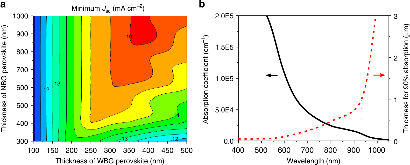Enhancing electron diffusion length in narrow-bandgap perovskites for efficient monolithic perovskite tandem solar cells
- Univ. of North Carolina, Chapel Hill, NC (United States)
- National Renewable Energy Lab. (NREL), Golden, CO (United States)
Developing multijunction perovskite solar cells (PSCs) is an attractive route to boost PSC efficiencies to above the single-junction Shockley-Queisser limit. However, commonly used tin-based narrow-bandgap perovskites have shorter carrier diffusion lengths and lower absorption coefficient than lead-based perovskites, limiting the efficiency of perovskite-perovskite tandem solar cells. In this work, we discover that the charge collection efficiency in tin-based PSCs is limited by a short diffusion length of electrons. Adding 0.03 molar percent of cadmium ions into tin-perovskite precursors reduce the background free hole concentration and electron trap density, yielding a long electron diffusion length of 2.72 ± 0.15 um. It increases the optimized thickness of narrow-bandgap perovskite films to 1000 nm, yielding exceptional stabilized efficiencies of 20.2 and 22.7% for single junction narrow-bandgap PSCs and monolithic perovskite-perovskite tandem cells, respectively. This work provides a promising method to enhance the optoelectronic properties of narrow-bandgap perovskites and unleash the potential of perovskite-perovskite tandem solar cells.
- Research Organization:
- Energy Frontier Research Centers (EFRC) (United States). Center for Hybrid Organic-Inorganic Semiconductors for Energy (CHOISE); National Renewable Energy Laboratory (NREL), Golden, CO (United States)
- Sponsoring Organization:
- USDOE Office of Science (SC), Basic Energy Sciences (BES); U.S. Department of Defense (DOD), Office of Naval Research; USDOE Office of Energy Efficiency and Renewable Energy (EERE), Renewable Power Office. Solar Energy Technologies Office
- Grant/Contract Number:
- AC36-08GO28308
- OSTI ID:
- 1570187
- Report Number(s):
- NREL/JA-5900-73936
- Journal Information:
- Nature Communications, Vol. 10, Issue 1; ISSN 2041-1723
- Publisher:
- Nature Publishing GroupCopyright Statement
- Country of Publication:
- United States
- Language:
- English
Web of Science
Highly Efficient Sn–Pb Perovskite Solar Cell and High‐Performance All‐Perovskite Four‐Terminal Tandem Solar Cell
|
journal | December 2019 |
Ultrathin microcrystalline hydrogenated Si/Ge alloyed tandem solar cells towards full solar spectrum conversion
|
journal | February 2020 |
Efficient CsSnI 3 -based inorganic perovskite solar cells based on a mesoscopic metal oxide framework via incorporating a donor element
|
journal | January 2020 |
Similar Records
Pressure-Induced Bandgap Optimization in Lead-Based Perovskites with Prolonged Carrier Lifetime and Ambient Retainability
Pressure-Induced Bandgap Optimization in Lead-Based Perovskites with Prolonged Carrier Lifetime and Ambient Retainability






